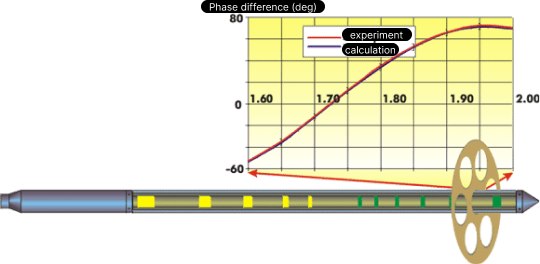VIKIZ High-Frequency Induction Logging Isoparametric Sounding Method
VIKIZ is designed for geophysical surveying of the open boreholes of vertical, horizontal and directional wells of 120–245 mm diameter being drilled for oil and gas, when tripping into and out of the borehole. The Complex is transported to the bottomhole on the three-core wireline.
search for both water/oil and gas/water contacts, and transition zone also
indication of a bordering zone
resistivity determination in the area from a well to the undisturbed part of formation
distinguishing reservoirs with estimation of effective thickness
visual express-estimation of the fluid saturation nature
Applications:
Vertical wells
Refinement of angles between a wellbore and formation penetrated by the wellbore
Estimation of electrical macroanisotropy in thinly bedded reservoirs
Resistivity determination of both formation and shoulder beds
Distinguishing of subhorizontal impermeable beds
Location of water/oil and gas/oil contacts within reservoir
Estimation of location of both the roof and bottom of a reservoir relative to a borehole
Wells with horizontal completion
The advantage of the method is the high spatial resolution improving the efficiency of thin-bedded formations surveying.
Specifications
Configuration
The VIKIZ equipment consists of the downhole and the surface tools. The first one includes the logging tool complex and electronic-measuring unit. The complex consists of five electromagnetic logging tools of different depths and the WP electrode.
Every logging tool contains one transmitting coil, and two receiver coils. The phase difference between voltages induced in the receivers. The recorded parameter is identically related to the resistivity of the rock, surrounding the well.
Every logging tool contains one transmitting coil, and two receiver coils. The phase difference between voltages induced in the receivers. The recorded parameter is identically related to the resistivity of the rock, surrounding the well.
digital information transfer through the conventional 3-vein wireline to the surface tool or to the logging station
phase difference and WP signal measurements
measuring coils signal conversion
electromagnetic field excitation in the environment
Electronic-measuring unit provides:
Characteristics of borehole tool:
The main purposes of the surface equipment are the receipt of the information from the downhole tool, its transformation to the form suitable for recording, and the storage of calibrating values. When using a computerized logging station, the surface tool can be substituted by a special program.
log viewing and editing
filtering
reservoir boundaries positioning
quantitative interpretation
MFS VIKIZ software
Diagram processing and interpretation are carried out with multifunctional system MFS VIKIZ
The system provides reconstruction of resistivity distribution in the frame of a stratified model, and includes the following functions:
The system provides reconstruction of resistivity distribution in the frame of a stratified model, and includes the following functions:
VIKIZ logs in the formations with different fluid saturation and the results of the interpretation
Hydro- and electrodynamic modeling (36 hours after the reservoir penetration)
The advanced processing includes joint interpretation of the VIKIZ data and the mud logging data on the basis of the hydrodynamically substantiated geoelectric model.
Calibration equipment
Profiling with the IM-1 set
The discrepancy between the model and experimental data does not exceed 3% in the entire measurement range.

Calibration equipment — border
«air-electrolyte»
«air-electrolyte»
A large volume tank filled with electrolyte



